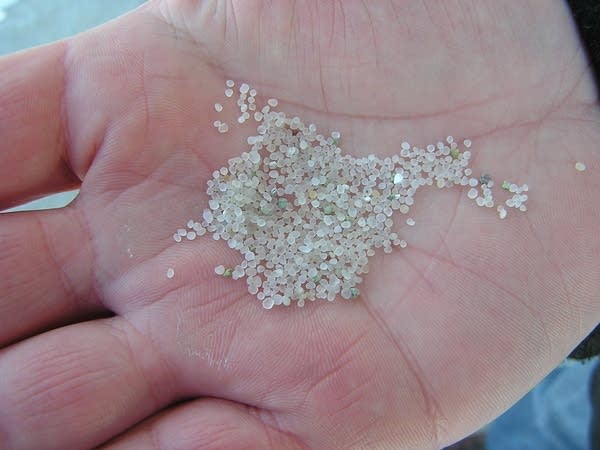Increase in natural gas production could slow interest in Minn. wind power

Minnesota is the nation's fourth largest producer of wind energy, but a potential game-changing development in natural gas production could erode interest in wind power.
In the Minnesota River valley town of Ottawa, near St. Peter, there's a big hole in the ground that's part of the rush to produce more natural gas.
Grey Lusty is a manager for the Unimin Corporation, a company mining silica sand in Ottawa and plans to expand production. The sand is used in a natural gas extraction process called hydraulic fracturing, or fracking, as it's known in mining slang.
When the sand is forced into underground rock formations, it breaks up the stone, releasing large amounts of natural gas. Lusty said the hard Minnesota sand is perfect for fracking, because it can withstand the intense pressure needed to break rock. It's so good, "Ottawa white" is known in the industry worldwide.
Create a More Connected Minnesota
MPR News is your trusted resource for the news you need. With your support, MPR News brings accessible, courageous journalism and authentic conversation to everyone - free of paywalls and barriers. Your gift makes a difference.
"Ottawa white is sort of the Coca-Cola of the frack sand industry," Lusty said.
Fracking has become such an important tool for the natural gas industry that demands for the sand outstrips supply. Fracking is the major reason why U.S. natural gas output has risen steadily in recent years after a decades-long decline.
In 2010, production reached levels last seen in 1973. The growing natural gas supplies have pushed prices down this winter to their lowest levels in nine years.

"It's been great news for energy consumers in America," said Phil Moeller, a member of the Federal Energy Regulatory Commission, or FERC.
Moeller said the good consumer news is tempered by environmental concerns. Environmentalists and other critics blast the fracking process, which involves a large amount of water and chemicals, saying it contaminates drinking water. The natural gas industry denies widespread problems. The EPA has promised a verdict next year.
FERC commissioner Moeller said if fracking survives the scrutiny, its impact will last decades. Besides cheaper heating and cooking costs, the lower prices also make natural gas more attractive as a fuel for electricity generation. But Moeller said if utilities turn more to natural gas, they may turn away from renewable energy resources like wind power.
"It's more difficult for them to compete," Moeller said.
Many power companies are now studying their options. Floyd Robb, with Basin Electric Power Cooperative in Bismarck, N.D., said his company is building a natural gas power plant right now in eastern South Dakota. The decision to build the plant was made before natural gas prices tumbled, but he said low gas prices could mean more such plants ahead.
"It certainly will play into our decisions for the future and what we would build for future generation," Robb said.
Robb said federal tax and other government incentives will help keep wind power competitive with natural gas. Right now, coal is still the cheapest source of electricity, at just over three cents per kilowatt hour. At its cheapest price recently, natural gas came close to beating that figure. With the incentives figured in, wind is around four cents.
But while a natural gas plant is always available to generate electricity, Robb said wind turbines cannot produce when the breezes are light.
"I would say that if anyone is contemplating a wind project today, they would be looking very closely at what natural gas prices are and what is going to ultimately be the lowest cost generation," Robb said.
There already are signs of a price war developing.
"What we've seen is that as the natural gas price has fallen, we've also seen wind costs falling," said Betsy Engelking, with Twin Cities-based Xcel Energy.
Engelking said she's seen wind farms lower the cost of their power by as much as 30 percent under what the company was expecting. That's partly because of an oversupply of turbines that is dragging down prices. Engelking though said the lower cost of wind power may also reflect the industry's attempt to remain competitive with abundant and low cost natural gas.
